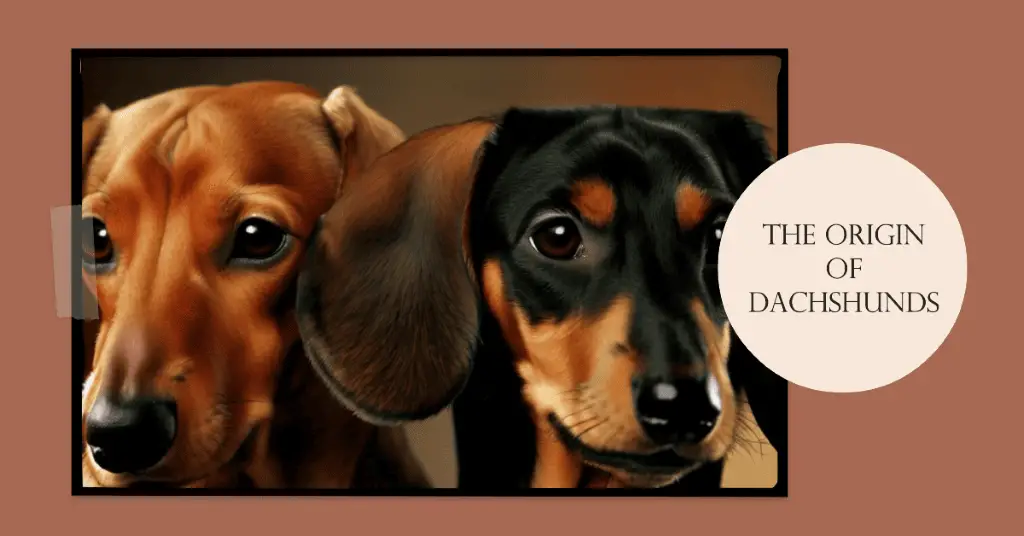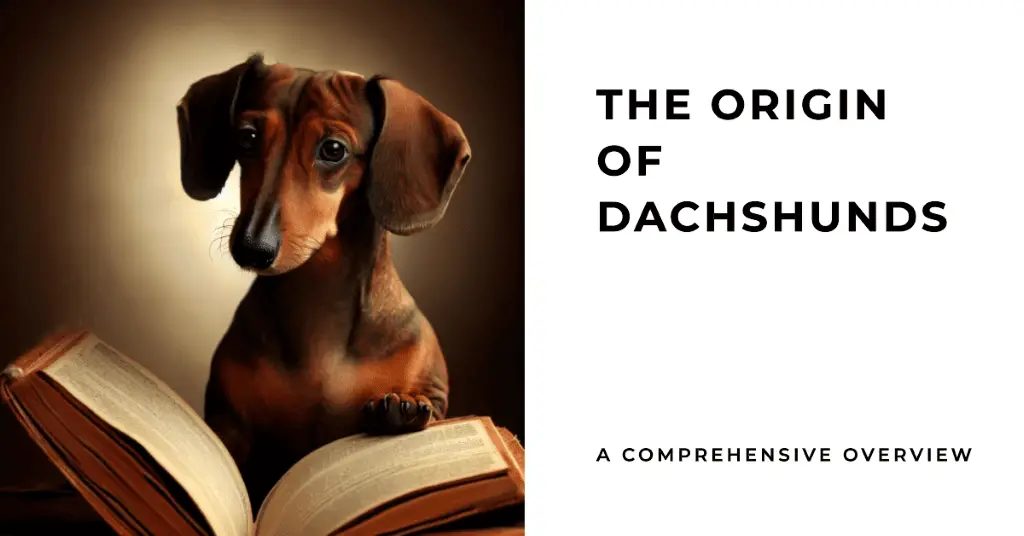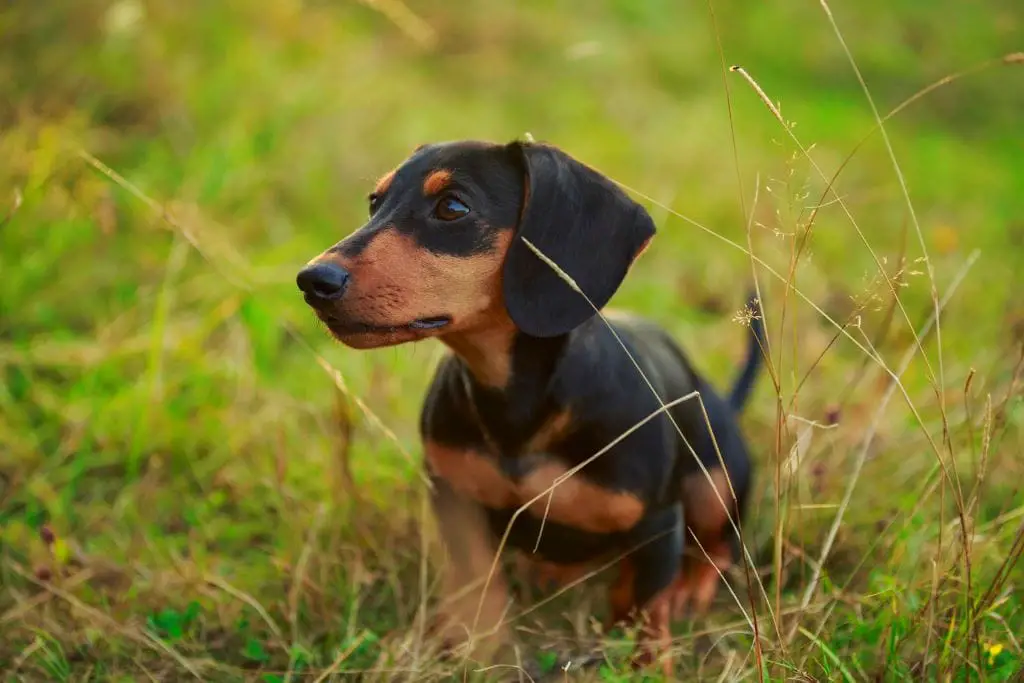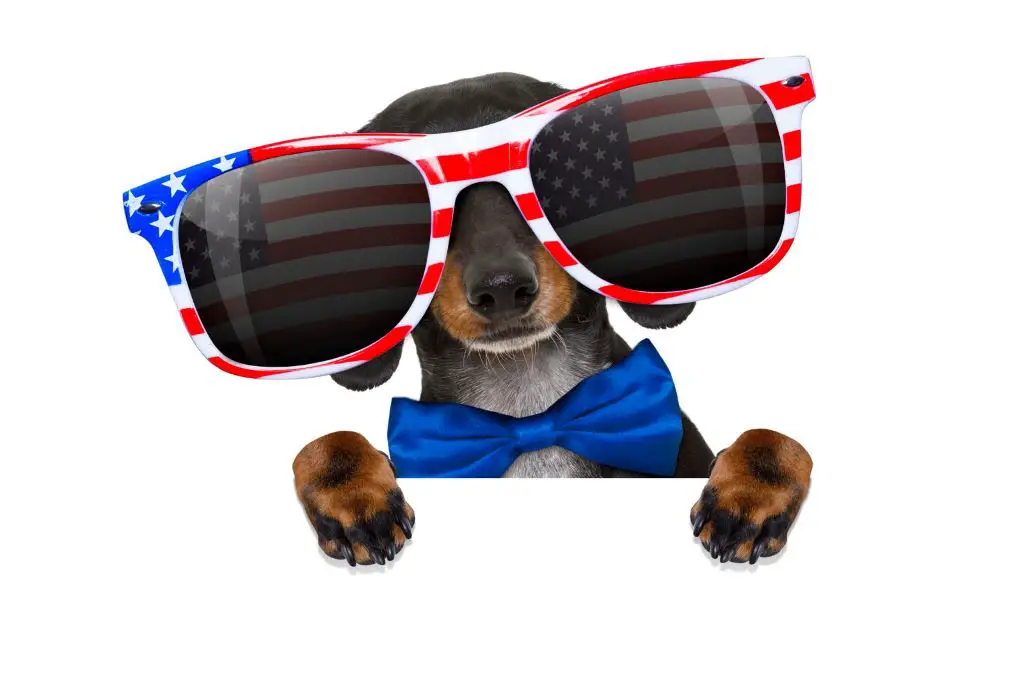Warning: Trying to access array offset on value of type bool in /home/u778996160/domains/dachshundtalk.com/public_html/wp-content/plugins/wp-word-count/public/class-wpwc-public.php on line 123
Warning: Trying to access array offset on value of type bool in /home/u778996160/domains/dachshundtalk.com/public_html/wp-content/plugins/wp-word-count/public/class-wpwc-public.php on line 123
Did you know that the dachshund is one of the most popular breeds in America? In fact, according to the American Kennel Club, they ranked 10th out of 195 breeds in popularity for 2020.
But do you know where these lovable pups originated from or how their unique appearance came about?
In this comprehensive overview of the origin of dachshunds, we will dive into their ancestry and evolution, as well as explore their distinctive breed characteristics.
From their hunting origins to their role in war, we will uncover fascinating facts about these beloved companions.
And if you’re a dachshund owner or considering adding one to your family, we’ll also share important information on their health and care needs.
So sit back, relax, and discover all there is to know about the history and traits of these adorable pups.
Dachshund History
The Dachshund has a rich history, with origins dating back to the 15th century in Germany. This breed was originally used for hunting badgers and other burrowing animals. Due to their unique long and low body shape, they were able to dig into tunnels and retrieve prey from underground.
Over time, the dachshund became a beloved companion dog breed in addition to being a skilled hunter. The origin of the dachshund is tied closely to German culture and heritage. The name ‘dachshund’ comes from two German words: ‘dachs,’ meaning badger, and ‘hund,’ meaning dog.
These dogs were prized for their courage and tenacity in the hunt, as well as their loyalty as family pets. Dachshunds also played a role in World War I as messenger dogs between trenches.
Today, the dachshund remains a popular dog breed around the world due to its charming personality and distinctive appearance. Whether you’re drawn to its short legs or playful nature, there’s no denying that this breed has captured hearts for generations.
As you learn more about the history of the dachshund, you can appreciate just how special these dogs truly are!
Ancestry and Evolution

You might be surprised to learn that dachshunds have a fascinating ancestry and evolution story. These brave little dogs were originally bred in Germany to hunt badgers over 300 years ago. Their name, “dachshund,” literally translates to “badger dog.”However, they weren’t just used for hunting badgers – they were also used for hunting other small game like rabbits and foxes.
The dachshund dog breed has a unique body shape that was specifically designed for their hunting purposes. Their long, narrow bodies and short legs allowed them to enter into the burrows of their prey with ease, while their powerful jaws made them excellent at catching and killing their targets.
But it wasn’t until the early 20th century that dachshunds became popular as family pets. Today, dachshunds are beloved by many families around the world for their loyalty, intelligence, and playful personalities. Despite being small in size, they have big hearts and make great companions.
So next time you see a dachshund on the street or in a park, remember their rich history as a fearless hunter breed with Germany!
Breed Characteristics
Get ready to learn about what makes dachshunds unique – their breed characteristics are truly fascinating!
Dachshunds are a small breed, but they have big personalities. They were originally bred in Germany to hunt badgers and other burrowing animals, which explains their long, low-slung bodies.
Dachshunds come in two sizes: standard and miniature. The standard size can weigh up to 32 pounds, while the miniature size weighs between 11-16 pounds. They also come in three coat types: smooth, wirehaired, and longhaired. Each type requires different grooming needs, with the longhaired needing more attention due to their longer hair.
The dachshund breed is known for its loyalty and feisty temperament. They may be small, but they have a big bark and will not hesitate to alert their owners of any potential danger or intruders. The kennel club standards describe them as being curious, playful, and outgoing dogs that make great family pets.
Overall, the dachshund breed is one-of-a-kind with its unique physical attributes and charming personality traits that make them beloved by many pet owners around the world.
Appearance and Traits
When considering a dachshund’s appearance and traits, it’s important to note their distinctive elongated bodies and short legs, which make them excellent diggers and hunters. Their compact size allows them to fit into tight spaces, making them ideal for going after burrowing animals like badgers.
This breed comes in three different coat varieties: smooth or shorthaired, longhaired, and wirehaired. The smooth or shorthaired dachshund has a sleek coat that lies close to the body. They require minimal grooming but are prone to shedding. The longhaired variety boasts soft, flowing locks that require regular brushing to prevent matting. And finally, the wirehaired dachshund has a coarse outer coat with a softer undercoat that requires regular grooming as well. Regardless of the type of coat they have, all dachshunds come in a range of colors, including black and tan, red, or cream.
Aside from their unique physical characteristics, dachshunds are known for their bold personalities. They’re fiercely independent dogs who love nothing more than being around people they trust. Despite their small stature, they’re incredibly confident and will often take on bigger dogs without hesitation if they feel threatened.
If you’re looking for an intelligent dog who is full of personality and always up for some fun-loving playtime, then consider adopting a dachshund!
Hunting Origins
With their elongated bodies and short legs, dachshunds were bred to be excellent hunters. Their hunting origins trace back to Germany during the 16th century. These dogs were specifically developed to hunt badgers, which were known for burrowing underground and causing damage to crops and livestock. The breed’s name comes from the German words ‘dachs,’ meaning badger, and ‘hund,’ meaning dog.
Apart from badgers, dachshunds were also used in hunting wild boars. During those times, these boars wreaked havoc on farmers’ lands by destroying their crops. Dachshunds’ long bodies allowed them to chase after these animals through dense forests while their powerful jaws enabled them to take down prey much larger than themselves.
As breed development continued over the years, dachshunds became more versatile hunters capable of taking on a wide variety of game animals such as foxes, rabbits, and even deer. Today they are still used for hunting purposes but have also become popular pets due to their loyalty and affectionate personalities.
With a strong hunting instinct still present in many dachshunds today, it’s important for owners to ensure that these pups receive proper training if they’re not being used for hunting. This will allow them to channel their energy into other activities like exercise or playtime with family members.
Dachshunds in War
Now that we’ve talked about the hunting origins of dachshunds, let’s dive into their role in the war.
Did you know that these little pups were actually bred for battle? That’s right – during World War I, soldiers from Germany used dachshunds as messenger dogs. Their small size and agility made them perfect for delivering messages across enemy lines.
But it wasn’t just World War I where dachshunds played a significant role. During World War II, they were used as guard dogs and even helped detect landmines.
These brave pups risked their lives to serve their country, proving that they are much more than just acute lap dog.
Despite their wartime efforts, dachshunds still remain popular today as beloved family pets. It’s important to remember the origin of this breed and how they have served not only as great hunting dogs but also in times of conflict.
Next time you see a dachshund wagging its tail, take a moment to appreciate all they have done for their country and mankind.
Global Popularity
It’s fascinating to see how dachshunds have gained global popularity as beloved pets. These adorable dogs have captured the hearts of dog lovers everywhere with their cute and quirky personalities.
Despite their origin dating back to Germany in the 16th century, these little pups are now found all over the world. Dachshunds come in a variety of colors and coat types, making them even more irresistible to those seeking a furry companion. They were originally bred for hunting badgers, but today they are better known for being loyal family pets.
In fact, they’re one of the most popular breeds in countries such as the United States and Brazil. These days, dachshunds are not only loved for their lovable personalities but also as a symbol of Germany. Their unique appearance has made them a favorite among tourists looking for souvenirs or gifts from Germany.
With their global popularity continuing to rise, it seems that these charming little dogs will continue to capture hearts around the world for many years to come!
Health and Care
To ensure your dachshund’s health and well-being, you should take them for regular check-ups with a veterinarian. They should receive vaccinations every three years, as recommended. This is particularly important because of the origin of dachshunds – they were bred to hunt badgers, which makes them more susceptible to injuries and infections from soil-borne diseases.
There are three types of dachshunds: standard, miniature, and toy. Each type has its own unique needs when it comes to health care. For instance, standard dachshunds tend to have more back problems due to their size, while miniature and toy dachshunds may be prone to dental issues. It is important to find a breeder who understands these differences so that you can choose a healthy puppy with good genes.
Taking care of your dachshund’s health requires more than just visits to the vet. You should also make sure that they get plenty of exercise through walks or playtime in a safe environment. Additionally, proper nutrition is essential for maintaining their overall well-being. Make sure that you feed your dachshund high-quality dog food that meets their specific nutritional needs based on their age, size, and activity level.
Overall, taking care of your dachshund’s health is crucial for ensuring a happy life together. By following these guidelines and working closely with your vet and breeder, you can help prevent health issues before they become serious problems. Remember that each type of dachshund has its own unique needs – understanding these differences will help you provide the best possible care for your furry friend!
Frequently Asked Questions
What is the average lifespan of a Dachshund and are there any common health issues?
Dachshunds typically live 12-15 years, but can have health issues such as back problems due to their long spine. Regular exercise and weight management can help prevent these issues. Always consult a vet for proper care.
What is the origin of the name “Dachshund,” and what does it mean?
Did you know that the name “dachshund” comes from German words meaning “badger dog”? These loyal pups were originally bred to hunt badgers and other burrowing animals. Now, they make great companions!
Are there any famous Dachshund owners or dogs in history?
You won’t believe the famous people who have owned dachshunds! From Queen Victoria to Pablo Picasso, these little dogs have stolen hearts throughout history. Join the ranks of elite dachshund owners today.
How do Dachshunds typically behave around children and other pets?
Dachshunds are known to be friendly and playful around children, but may require supervision with other pets. They enjoy being part of the family and will happily cuddle up with their humans.
Can Dachshunds be trained for agility or other sports?
Yes, dachshunds can be trained for agility and other sports. They are intelligent and energetic dogs that love to learn new things. With proper training, they can excel in a variety of activities and be a great companion for you.
Conclusion
From their hunting origins to their roles in war, dachshunds have a rich history that has contributed to their global popularity today. But owning a dachshund is not just about having a cute companion.
It also requires responsible pet ownership, including proper health care and attention to their unique characteristics and traits. Remember, as the saying goes, “a dog is not just for Christmas,” so make sure you’re ready for the commitment before bringing home one of these adorable pups.









